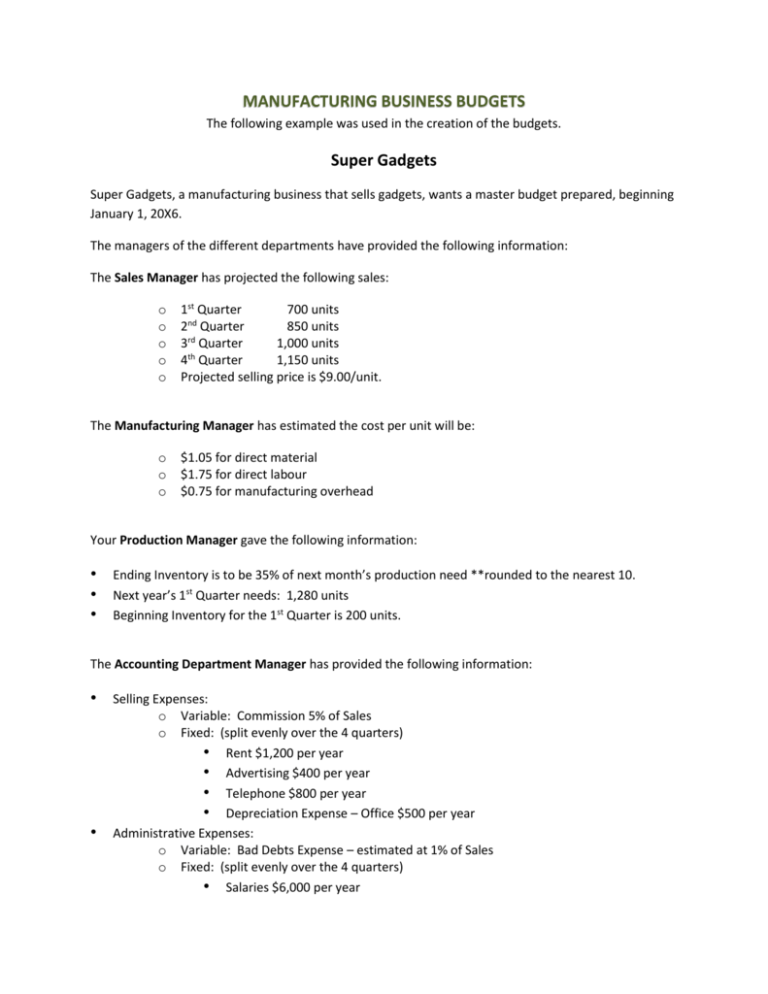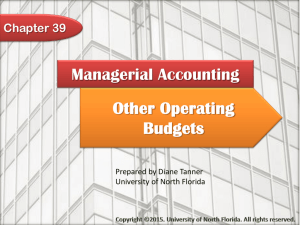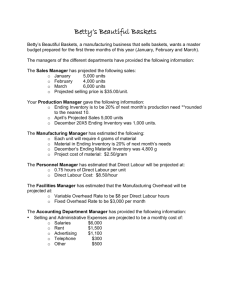Sales Budget - Manufacturing Business
advertisement

MANUFACTURING BUSINESS BUDGETS The following example was used in the creation of the budgets. Super Gadgets Super Gadgets, a manufacturing business that sells gadgets, wants a master budget prepared, beginning January 1, 20X6. The managers of the different departments have provided the following information: The Sales Manager has projected the following sales: o o o o o 1st Quarter 700 units 2nd Quarter 850 units rd 3 Quarter 1,000 units 4th Quarter 1,150 units Projected selling price is $9.00/unit. The Manufacturing Manager has estimated the cost per unit will be: o o o $1.05 for direct material $1.75 for direct labour $0.75 for manufacturing overhead Your Production Manager gave the following information: • • • Ending Inventory is to be 35% of next month’s production need **rounded to the nearest 10. Next year’s 1st Quarter needs: 1,280 units Beginning Inventory for the 1st Quarter is 200 units. The Accounting Department Manager has provided the following information: • • Selling Expenses: o Variable: Commission 5% of Sales o Fixed: (split evenly over the 4 quarters) • Rent $1,200 per year • Advertising $400 per year • Telephone $800 per year • Depreciation Expense – Office $500 per year Administrative Expenses: o Variable: Bad Debts Expense – estimated at 1% of Sales o Fixed: (split evenly over the 4 quarters) • Salaries $6,000 per year • • • • • • • • • • • • Insurance $440 per year Telephone $800 per year Supplies $200 per year Other Expenses $400 per year Cash Receivable: o 4th Quarter Sales of previous year was $900 o 90% of sales is collected in the quarter in which they were made o 9% of sales collected in the following quarter in which they were made o 1% of sales is uncollectible Accounts Payable: o One half of a month’s purchases are paid for in the quarter of purchase; the other half is paid for in the following quarter. o The accounts payable balance on December 31 of the previous quarter is $300 Federal Income Tax is estimated at 25% average. Depreciation of Manufacturing Overhead is $200 divided evenly over the 4 quarters. Super Gadgets has a $10,000 cash balance for the beginning of the 1st quarter Super Gadgets borrowed $10,000 in the 1st Quarter and paid it back in the 4th Quarter. Dividends of $5,000 are to be paid in the fourth quarter. From the beginning Balance Sheet: o Land = $20,000 o Building = $148,000 o Depreciation (Building) = $33,000 o Retained Earnings = $51,717.50 o Capital Stock = $90,000 Sales Budget - Manufacturing Business Highlights predicts dollars of sales is the first schedule prepared because many other schedules are dependent on it shows expected sales and units of production is the key to the entire process typically expressed in both dollars and units of product uses expected selling price to extend unit sales to revenues is often started by individual sales persons or managers predicting sales in their own area for the next period of time an aggregate sales budget is influenced by economic conditions, pricing decisions, competition, marketing programs, etc. Steps: Preparing a Sales Budget 1. Record the projected units broken down by quarters (this information is provided by the sales manager). 2. Record the Projected Selling Price per Unit. 3. Calculate the estimated amount of sales. Sample Sales Budget Production Budget - Manufacturing Firm Highlights an estimate of the number of units to be produced in the next fiscal year uses the sales budget for projected units needed the production budget is the basis for projecting the Cost of Goods Manufactured Budget a manufacuring firm prepares the production budget instead of a purchases budget is similar to the purchases budgets except the number of units to be purchased is replaced by the number of units to be manufactured expressed in units of product Steps: Preparing a Production Budget 1. Record projected units to be sold (from Sales Budget). 2. Record desired number of units in ending inventory. (Usually a percentage of next quarter's needs). 3. Add to determine the Units needed. 4. Record the projected units in beginning inventory. **Beginning inventory is last quarter's ending inventory. 5. Subtract to determine the projected producMay 31, 2005 1:31 PMction Budget Cost of Goods Sold - Manufacturing Business Highlights once the Sales Budget has been completed, an estimate of Cost of Goods Sold can be prepared applies only to manufacturing businesses production runs would be scheduled estimates Labour, Material and Overhead Steps: Preparing Cost of Goods Sold 1. 2. 3. 4. 5. Record projected sales units (fom Sales Budget). Multiply by the Direct Material Cost per Unit to estimate Direct Materials. Multiply by the Direct Labour Cost per Unit to estimate Direct Labour. Multiply by the Manufacturing Overhead per Unit to estimate Overhead. Total. Sample Cost of Goods Sold Direct Labour Budget Manufacturing Business Highlights once the Production Budget has been completed, the Direct Labour Budget can be prepared allows the company to know in advance possible labour requirements typically expressed in labour hours and dollars Steps: Preparing a Direct Labour Budget 1. Record projected units to be produced (from Production Budget). 2. Multiply by the Direct Labour Cost per Unit to calculate the Total Direct Labour Cost. Sample Direct Labour Budget Direct Materials Purchases Budget Manufacturing Business Highlights provides an estimate of the dollar amount of the direct materials to be purchased in the next fiscal year once the Direct Materials Budget has been completed, a Schedule of Expected Cash Disbursements is completed Steps: Preparing a Direct Materials Purchases Budget 1. Record projected units to be produced (from Production Budget). 2. Multiply by the Raw Materials Needed per Unit to calculate the amount of materials needed. 3. Calculate the desired ending inventory (usually a percentage of next quarter's needs). 4. Add to calculate Total Materials needed. 5. Subtract the beginning inventory (which is last quarter's ending inventory) to calculate the Raw Materials Needed to be Purchased. 6. Calculate the Cost of Raw Materials based on price per kilogram. 7. Complete the Schedule of Expected Cash Disbursements according to percentages provided. Overhead Budget - Manufacturing Business Highlights typically expressed in dollars should provide a schedule of all costs of production other than direct materials and direct labour provides an estimate of the overhead cost that will be incurred in the next fiscal year based on a predetermined overhead rate Steps: Preparing a Manufacturing Overhead Budget 1. Record projected units to be produced (from Production Budget). 2. Multiply by the Variable Overhead Rate to calculate the Bugeted Variable Overhead. 3. Add any Budgeted Fixed Overhead to calculate the Total Budgeted Overhead. 4. Subtract the Depreciation to calculate the Cash Disbursements for overhead. Sample Manufacturing Overhead Budget Selling Expenses Budget Manufacturing Business Highlights anticipates selling expenses from the Sales and Cost of Goods Sold budgets may include the budgets of various individuals or groups involved in selling may be combined with the Administrative Expenses Budget selling expenses portion contains both variable (shipping costs, sales commission) and fixed (advertising and sales salaries) items Steps: Preparing a Selling Expenses Budget 1. 2. 3. 4. 5. 6. Record projected Unit Sales (from Sales Budget). List the Variable Selling Expenses and calculate based on guidelines provided. List the Fixed Selling Expenses and calculate based on guidelines provided. Add to calculate the Total Budgeted Selling Expenses. List any Depreciation Expense. Subtract to calculate Cash Requirement for Selling Expenses. Administrative Expenses Budget - Manufacturing Business Highlights anticipates administration expenses from the Sales and Inventory/Cost of Goods Manufactured budgets may include the budgets of various individuals or groups involved in administration may be combined with the Selling Expenses Budget administrative expenses portion contains mostly fixed items (executive salaries and depreciation on company offices) Steps: Preparing an Administrative Expenses Budget 1. 2. 3. 4. 5. List the Variable Administrative Expenses and calculate based on guidelines provided. List the Fixed Administrative Expenses and calculate based on guidelines provided. Add to calculate the Total Administrative Expenses. List any Bad Debts Expense. Subtract to calculate the Cash Requirement for Administrative Expenses. Sample Administrative Expenses Budget Budgeted Income Statement Manufacturing Business Highlights illustrates a company's projected sales, costs, expenses and net income based on: Sales, Purchases, Selling Expenses and Administrative Expense Budgets used to project net income or loss able to project federal income tax Steps: Preparing a Budgeted Income Statement 1. 2. 3. 4. 5. 6. 7. 8. 9. Record Net Sales from the Sales Budget. Record Cost of Goods Sold Record Operating Expenses (Selling and Administrative) Total Operating Expenses Net Income from Operations = Sales – (Cost of Goods Sold + Operating Expenses) Record any Interest Expense Federal Income Tax is calculated at a percentage of Gross Income. Net Income = Income from Operations – Federal Income Tax Complete the Budget of Collections of Accounts Receivable according to percentages provided. Sample Budgeted Income Statement Cash Budget - Manufacturing Business Highlights management of cash is crucial to meeting debt obligations as they come due without having excess cash idle major goal of all organizations is liquidity - pay all debts when they come due purpose: to optimize cash balances; having enough cash to meet liquidity needs and not having so much cash that profitability is sacrificed pulls together other budgets Steps: Preparing a Cash Budget 1. 2. 3. 4. 5. 6. 7. 8. Record the Cash Balance - Beginning for the 1st Quarter. Record the Cash Receipts (from the Budget of Collections of Accounts Receivable). Add to calculate Cash Available. Record the Cash Payments (Materials, Labour, Overhead, Selling& Administrative Expenses, Income Taxes, Dividends, etc). Total the Cash Payments. Subtract to calculate the Excess or Deficiency of Cash Available. Record any Financing information and calculate a total. Subract to calculate the Cash Balance - Ending. Sample Cash Budget Budgeted Balance Sheet Manufacturing Business Highlights the final step in preparing the master budget summarizes the company's financial position predicts amounts of the company's assets, liabilities and equity at the end of the budget period Steps: Preparing a Budgeted Balance Sheet 1. Record the assets by analyzing the Purchases Budget, Cash Receipts Budget and the beginning balance sheet for the budget period. 2. Record the liabilities by analyzing the Expense Budgets and the Cash Payments Budget. 3. Calculate the equity by analyzing the information contained in the Cash Budget, the Budgeted Income Statement and the beginning balance sheet for the budget period. Sample Budgeted Balance Sheet Source: http://www.spiritsd.ca/curr_content/acct30rev/mod3/manubus/budbalshtMan.html Betty’s Beautiful Baskets Betty’s Beautiful Baskets, a manufacturing business that sells baskets, wants a master budget prepared for the first three months of this year (January, February and March). The managers of the different departments have provided the following information: The Sales Manager has projected the following sales: o o o o January 5,000 units February 4,000 units March 6,000 units Projected selling price is $35.00/unit Your Production Manager gave the following information: o o o Ending Inventory is to be 20% of next month’s production need **rounded to the nearest 10 April’s Projected Sales 5,000 units December 20X5 Ending Inventory was 1,000 units The Manufacturing Manager has estimated the following: o o o o Each unit will require 4 grams of material Material in Ending Inventory is 20% of next month’s needs December’s Ending Material Inventory was 4,800 g Projected cost of material: $2.50/gram The Personnel Manager has estimated that Direct Labour will be projected at: o o 0.75 hours of Direct Labour per unit Direct Labour Cost: $8.50/hour The Facilities Manager has estimated that the Manufacturing Overhead will be projected at: o o Variable Overhead Rate to be $8 per Direct Labour hours Fixed Overhead Rate to be $3,000 per month The Accounting Department Manager has provided the following information: • Selling and Administrative Expenses are projected to be a monthly cost of: o Salaries $6,000 o Rent $1,500 o Advertising $1,100 o Telephone $300 o Other $500 • Cash Receivable: o December’s Sales were $10,000 o 80% of sales is collected in the quarter in which they were made o 20% of sales collected in the following quarter in which they were made o Bad Debts is negligible • Accounts Payable: o 80% of Payables is paid for in the current month o 20% of Payables is paid for in the following month o December’s Payables were $75,000 • Federal Income Tax is estimated at 22% average. • Betty’s Beautiful Baskets o has a $20,000 cash balance for the beginning of January o pays Dividends of $8,000 to be paid in March o pays projected Federal Income tax in March • From the beginning Balance Sheet: o Land = $150,000 o Building = $45,000 o Depreciation (Building) = $11,250 o Retained Earnings = $58,780 o Capital Stock = $225,000 o For the Master Budget, you are expected to prepare the following: • • • • • • • • • • Sales Budget Cost of Goods Sold Budget Selling & Administrative Expenses Budget Production Budget Direct Materials Budget plus a Schedule of Expected Cash Disbursements Direct Labour Budget Manufacturing Overhead Budget Budgeted Income Statement plus a Budget of Collections of Accounts Receivable Cash Budget Budgeted Balance Sheet




